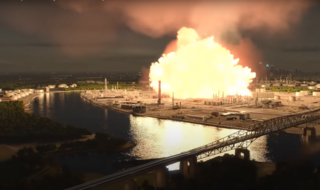
A boiling liquid expanding vapor explosion is an explosion caused by the rupture of a vessel containing a pressurized liquid that is or has reached a temperature sufficiently higher than its boiling point at atmospheric pressure. Because the boiling point of a liquid rises with pressure, the contents of the pressurized vessel can remain a liquid as long as the vessel is intact. If the vessel's integrity is compromised, the loss of pressure drops the boiling point, which can cause the liquid to convert to gas expanding rapidly. BLEVEs are manifestations of explosive boiling.

The Texas City refinery explosion occurred on March 23, 2005, when a flammable hydrocarbon vapor cloud ignited and violently exploded at the isomerization process unit of the BP oil refinery in Texas City, Texas, killing 15 workers, injuring 180 others and severely damaging the refinery. All the fatalities were contractors working out of temporary buildings located close to the unit to support turnaround activities. Property loss was $200 million. When including settlements, costs of repairs, deferred production, and fines, the explosion is the world's costliest refinery accident.
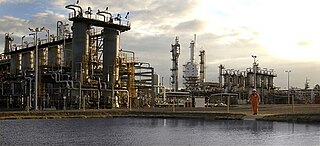
On 25 September 1998 a catastrophic accident occurred at the Esso natural gas plant in Longford, Victoria, Australia. A pressure vessel ruptured resulting in a serious jet fire, which escalated to a conflagration extending to a large part of the plant. Fires lasted two days before they were finally extinguished.

The Delaware City Refinery, currently owned by Delaware City Refining Corporation, a subsidiary of PBF Energy, is an oil refinery in Delaware City, Delaware. When operational it has a total throughput capacity of 210,000 barrels per day (33,000 m3/d), and employs around 570 individuals.

Nihon Dempa Kogyo Co., Ltd. or NDK is one of the world's largest quartz crystal companies, based in Shibuya, Tokyo, Japan.
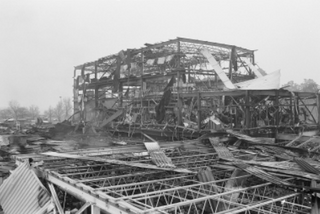
The West Pharmaceutical Plant explosion was an industrial disaster that occurred on January 29, 2003, at the West Pharmaceutical Plant in Kinston, North Carolina, United States. Six people were killed and thirty-six people were injured when a large explosion ripped through the facility. Two firefighters were injured in the subsequent blaze. The disaster occurred twelve years and 170 miles (270 km) from the 1991 Hamlet chicken processing plant fire, North Carolina's second-worst industrial disaster.

The T2 Laboratories explosion and fire occurred on December 19, 2007, in Jacksonville, Florida, resulting in the deaths of four people and the injury of fourteen others. T2 Laboratories Inc. was a facility that specialized in the manufacture of specialty chemicals primarily for gasoline additives.

On 7 February 2008, fourteen people were killed and thirty-six injured during a dust explosion at a refinery owned by Imperial Sugar in Port Wentworth, Georgia, United States. Dust explosions had been an issue of concern among U.S. authorities since three fatal accidents in 2003, with efforts made to improve safety and reduce the risk of reoccurrence.
The 2010 Connecticut power plant explosion occurred at the Kleen Energy Systems power station in Middletown, Connecticut, United States at 11:17 am EST on February 7, 2010. The plant had been under construction from September 2007, and was scheduled to start supplying energy in June 2010. The initial blast killed five and injured at least fifty; one of the injured later died in hospital, bringing the total death toll to six.
The Marathon Martinez Renewable Fuels Facility is located in the San Francisco Bay Area in an unincorporated area known as Avon, East of Martinez, California. It refines biobased feedstocks such as animal fat, soybean oil and corn oil into renewable diesel. Previously owned by Tidewater Petroleum, Tosco, Valero Energy, Tesoro and Marathon Petroleum. The refinery is located on 850 acres, in 2016 had approximately 650 full-time employees, and had a crude oil capacity of 157,000 barrels per day. In 2015 it was the fourth-largest refinery in the state. The refinery had a Nelson complexity index of 16.1.

On June 10, 1999, the Olympic pipeline operated by Olympic Pipeline Company, carrying gasoline at the time, exploded in Whatcom Falls Park in Bellingham, Washington. The disaster began at 3:25 PM PDT when an underground gasoline pipeline crossing Whatcom and Hanna Creeks ruptured. The incident was caused by a series of errors and malfunctions involving Olympic Pipeline, compounded by an excavator's failure to call in and locate the damaged section. The gasoline vapors exploded at 5:02 PM PDT, sending a fireball down Whatcom Creek. Three people died in the incident.

On April 17, 2013, an ammonium nitrate explosion occurred at the West Fertilizer Company storage and distribution facility in West, Texas, United States, while emergency services personnel were responding to a fire at the facility. Fifteen people were killed, more than 160 were injured, and more than 150 buildings were damaged or destroyed. Investigators confirmed that ammonium nitrate was the material that exploded. On May 11, 2016, the Bureau of Alcohol, Tobacco, Firearms and Explosives stated that the fire had been deliberately set. That finding has been disputed.
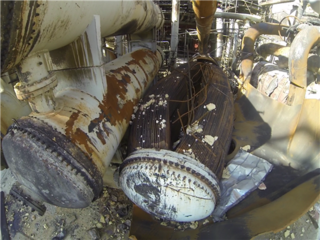
The Williams Olefins Plant explosion occurred on June 13, 2013 at a petrochemical plant located in Geismar, an unincorporated and largely industrial area 20 miles (32 km) southeast of Baton Rouge, Louisiana. Two workers were killed and 114 injured. The U.S. Occupational Safety and Health Administration (OSHA) and the U.S. Chemical Safety and Hazard Investigation Board (CSB) launched investigations to determine how and why the heat exchanger failed. The Chemical Safety Board concluded that a standby heat exchanger had filled with hydrocarbon. This heat exchanger was isolated from its pressure relief; shortly after the heat exchanger was heated with hot water, the hydrocarbon flashed to vapor, ruptured the heat exchanger, and exploded.

The Anacortes Refinery is a petroleum refinery located about 70 miles north of Seattle on March Point, just outside Anacortes, Washington, United States. The refinery has operated in Anacortes since 1955, and has 425 full-time employees. It has a 120,000 barrels per day (bpd) capacity and is operated by Marathon Petroleum.

The Puget Sound Refinery is an oil refinery on March Point near Anacortes, Washington, United States. It is operated by HF Sinclair and is one of the largest employers in Skagit County. The refinery has a capacity of 145,000 barrels a day, making it the 52nd largest in the United States, in 2015, with facilities that include a delayed coker, fluid catalytic cracker, polymerization unit and alkylation units. HF Sinclair’s refinery produces three grades of gasoline, fuel oil, diesel fuel, propane and butane. This plant is currently the only refinery in Washington state unable to accommodate tight oil via rail. The permitting process is currently underway for the proposed 60,000 b/d unloading capacity of the East Gate Rail Project.
An explosion at the ARCO Chemical (ACC) Channelview, Texas petrochemical plant killed 17 people and injured five others on July 5, 1990. It was one of the deadliest industrial disasters in the history of the Greater Houston area.

On April 26, 2018, an explosion and subsequent fire occurred at the Husky Energy Oil Refinery in Superior, Wisconsin. An initial explosion was reported at 10:00 AM and was extinguished close to noon, however a piece of debris had hit a storage tank containing asphalt, which ignited after spilling across the refinery, sending a thick plume of black smoke into the air. Thirty-six people, including 11 refinery employees, were sent to local hospitals, but there were ultimately no fatalities. Residents 3 miles to the east and west of the refinery, 2 miles to the north, and 10 miles to the south were evacuated from their homes temporarily due to concerns of both the toxicity of the smoke affecting those who lived south of the refinery and concerns regarding the plant's hydrofluoric acid tank causing further damage.
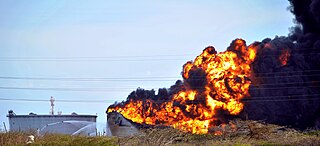
The Amuay tragedy was an explosion of the Paraguaná Refinery Complex in Punto Fijo, Venezuela. The explosion resulted in the death of 48 people and injured 151 others.















